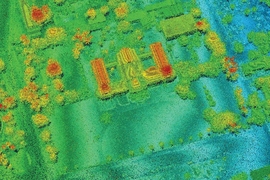Producing torrential rain and wind gusts exceeding 180 miles per hour as it made landfall in the Philippines, Typhoon Haiyan left more than 6,000 dead and 4 million homeless. The November 2013 storm also obliterated thousands of hectares of crops, mostly rice, the staple food for about 90 percent of the population. Host to six to nine tropical cyclones per year since 1970, and a citizenry that consumes more rice than it produces, the Philippines has for many years augmented its homegrown supply of rice with imports based on seasonal climate forecasts and agricultural production surveys. But import orders must be modified on the fly when extreme weather events exact a heavier toll on production than expected.
In the aftermath of Haiyan, the Philippine government approved the import of an extra 355,000 metric tons of rice based on initial rough estimates of rice production damage and subsequent, more accurate assessments drawn from time-consuming surveys in hundreds of villages. Seeking to enable a more rapid response, researchers have now developed a method that can provide a more immediate and precise estimate of typhoon-inflicted rice damage in the Philippines.
Developed by Elodie Blanc, a research scientist at the MIT Joint Program on the Science and Policy of Global Change, and Eric Strobl, an associate professor of economics at École Polytechnique in France, the method is described in the Journal of Applied Meteorology and Climatology.
“Our method provides a faster, more accurate, and easier-to-obtain estimate of the impact of typhoons on rice production, and could empower governments in the Philippines and other tropical storm-prone nations to respond more quickly,” says Blanc, who is also developing the technique for use in Taiwan and Burma. “Our full methodology could be applied not only to other countries but also to other crops.”
To quantify the impact of typhoons on rice production at the province level in the Philippines, Blanc and Strobl applied a set of simple algorithms to publicly available satellite data. First, they used satellite-based spectral measurements of the Earth’s surface to pinpoint the location and growth phases of Philippine rice fields at a 500-meter resolution. Next, they modeled wind and rain-driven damage to these fields using typhoon-track data and rainfall measurements, resulting in a provincial-level rice damage index that decision-makers can use to adjust imports.
Their analysis showed that typhoons caused dramatic reductions in local rice production within three months of a typhoon’s landfall, with losses of up to 12.5 million metric tons between 2001 and 2014. Using a statistical method called extreme value theory to predict future losses, they determined that a storm like Haiyan — estimated to have reduced rice production by 260,000 metric tons — is likely to recur once every 13 years.
As climate change continues to increase the frequency and intensity of tropical cyclones and other extreme weather events, the researchers expect to see rising demand for their crop damage assessment technique.
The study was funded by the U.S. Department of Energy, the U.S. Environmental Protection Agency, and other government, industry, and foundation sponsors of the Joint Program.









